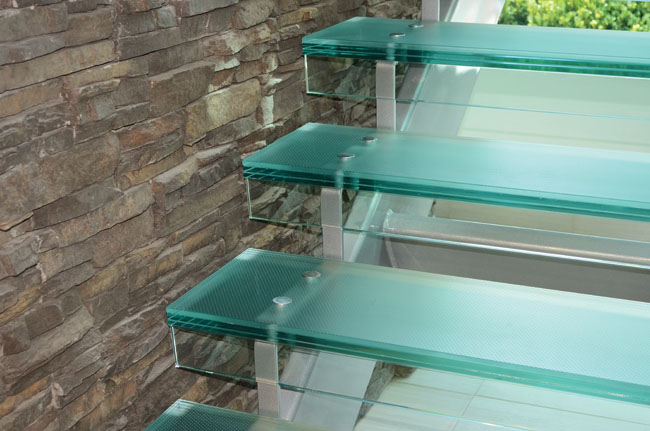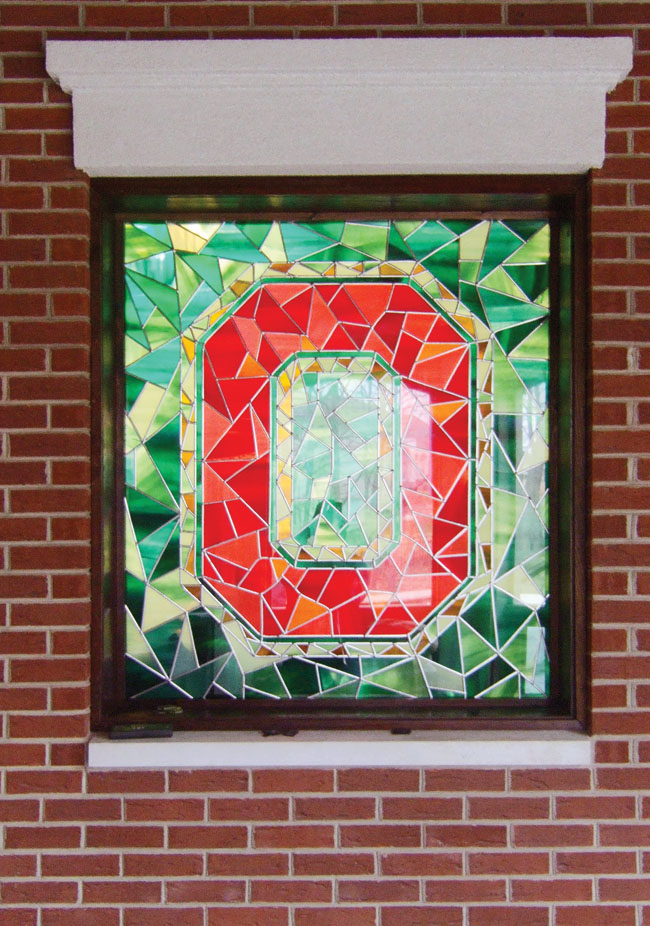Ever since stained glass made the jump from cathedrals and castles to the front door of the common man, art glass has represented the ideal union of aesthetics and function—delivering privacy while adding beauty. Today, as the economy eases upward, many homeowners are shaking the dust off their remodeling plans and finding fresh reasons why art glass installations —whether stained, leaded, pebbled, back-painted, carved, etched or textured—are more than just a pretty face for the front door. Photo courtesy of Stained Glass Overlay
Created by Pittsburgh artist Jeffrey Phelps, this one of a kind glass backsplash is called “Tree of Life Moonlight Sonata.”
A lot of people are dressing up the home they have. They’ve been thinking about doing an art glass design for a long time, and decide to just do it,” says Dan Burgess of Stained Glass Overlay, a stained glass manufacturer and installer in Elsmere, Ky. “It’s not all that expensive and totally transforms a room.”
There’s a reason why leaded glass designs have become the most popular option for the windows that are often installed over garden tubs: Beyond its privacy wielding power, art glass is an ideal substrate for adding style to spaces that need to have a clean look and even cleaner surfaces. Photo courtesy of Stained Glass Overlay
Billy Klausner, founder and owner of Crystal Illusions, a custom glass company in Cleveland, says back-painted glass—in which color is infused to the back side of a sheet of tempered glass —has become a popular option for shower walls and kitchen backsplashes because it provides saturated color and a dazzling reflective quality, but also because it usually requires a lot less elbow grease to clean than ceramic tiles. There are no grout lines, and the naturally non-porous material is treated with a polymer coating to resist hard-water staining, Klausner says.
Recycled glass countertops have moved into the mainstream as well. For frameless shower enclosures, textured glass has become an equally durable and low-maintenance option, Burgess says. Photo courtesy of Vetrazzo
In the bathroom, vessels crafted from glass are a popular way to punctuate a custom design.
While lighting is hugely important for bringing any art glass installation to life, some homeowners are moving beyond natural light and adding LEDs beneath the glass vessels, creating a dramatic glow, Klausner says.
From the bathroom to the patio, many people are turning to art glass to provide in-house and outdoor privacy. Window created by Cathy Parkinson
As people finish lower level spaces into entertainment areas, they are looking to make them as comfortable and attractive as their first-floor living, and stained glass windows are one way to create the environment.
“People are doing faux windows with artificial light behind them to get more light into the basement,” says Andrea Reid with Franklin Art Glass Studios in Columbus, Ohio.
Placing decorative glass in cabinet doors continues to be a popular way to set the style of a kitchen, says Joe Cannata, owner of Hyde Park Art Glass in Tampa. Restoration glass—with its historic, wavy look, is particularly in demand, he says.
But some homeowners are expanding on the project and utilizing the power of glass to visually expand their kitchen. In addition to replacing the recessed panels from each door with leaded glass or clear architectural glass, Cannata replaces the cabinet shelving with glass as well—creating an open feel.
Beyond carrying a front door design to the sidelights and transom, many people are continuing the design throughout their first-floor space, just as they would with any other architectural element.
The additional installations might include the door of an office located just off the front door or divider panels added between the kitchen and dining room, says John Root, owner of SGO Designer Glass in Dayton, Ohio. Frank Lloyd Wright-influenced designs are the most popular for this application, he says, because they complement a range of styles.
A handful of truly progressive homeowners are using glass to bring artistic flair to the humble staircase, as well as the catwalk design found in many floor plans.
Installers with Emerald Art Glass in Pittsburgh often bring in glass floors and stair treads, as well as glass panels in place of traditional railings and balusters.
Photo courtesy of Rex Glass in Pittsburgh
Five years ago, many people would’ve been hesitant to incorporate such grand—and permanent—features. And while many still opt for neutral tones and themes, others now see an art glass installation—and their home—as a way to express their tastes. Photo courtesy of Designer Glass Mosaics in Charlotte
“People are staying in their homes, so there’s more of a trend of personalizing. They’re not as concerned about resale,” Root says.
Though should it come time to move, homeowners may opt to simply take their art glass with them, just as they would any cherished piece of artwork. Photo courtesy of SGO Dayton
While not all installations can be easily uprooted, features like windows and doors are “a little more transportable than people think,” Reid says. “Some people will call and say they’re planning to sell and want to take the glass with them, so we go back and replace it with clear glass. It can last 75 to 100 years, so you’re buying an enduring piece of artwork.” Photo courtesy of Franklin Art Glass Studios in Columbus, Ohio.















